Pentastar Engines: Overview and Technical Details
The 3.6 liter Pentastar engine is rated at 305 horsepower and 270 lb.-ft. of torque in the Dodge Challenger; 90% of torque is available from 1,800 to 6,350 rpm, real-world punch. In the Ram, the engine is also rated at 305 horsepower, and 269 lb-ft of torque. The smaller 3.2 liter Pentastar in the Jeep Cherokee is rated at 271 horsepower and 239 lb-ft of torque.
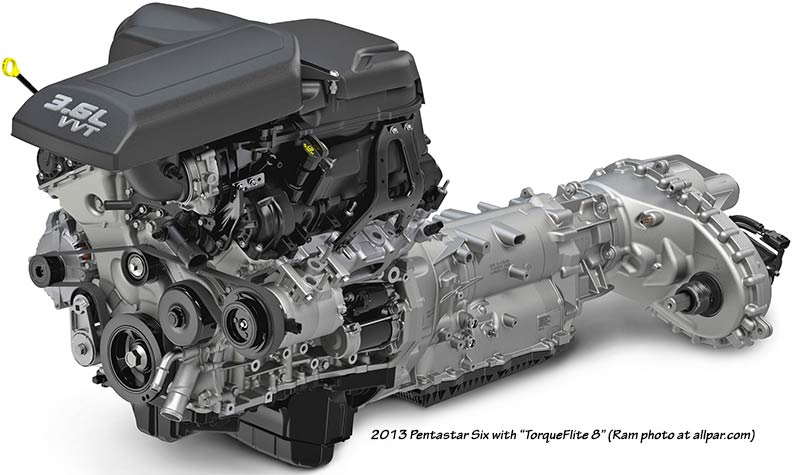
The Pentastar engines have an open deck design, with four oil return holes below the head bolt holes; dana44 wrote, “The bottom two outer head bolts should have guides to keep the heads lined up properly; the extra hole in the upper rear, I assume, is the oil supply. I think we are also looking at six bolt main caps, but at least four bolts, two or four vertical and two horizontal...I think the [open area below the oil returns] are oil drainback holes. The feed is at the upper rear of the cylinder on the bank you can see, what appears to be a hole next to the head bolt.”
The open deck makes manufacturing cheaper, at the cost of upper cylinder support; there have been numerous open deck engines in Chrysler’s history, including the aluminum slant six and the current four-cylinders. A turbocharger could be added without changing the deck machining, using special O-ringed head gaskets or other methods.

A twin turbo and single-turbocharger version were originally planned for introduction by 2014; both would be based on the smallest size (3.0 liters) and might be slated for limited-production models (e.g. a new Viper based on a Maserati or an SRT mid-sized car). The twin-turbo version was projected for a whopping 420 horsepower while the single-turbo was set for 370 hp; developed by Maserati and Ferrari, the 3.0 twin turbo ended up at 404 horsepower. The twin turbo uses different heads and internal parts, with modified blocks, but shares the same basic design; and the blocks are sourced from Chrysler.
See more Pentastar engine details, rumors, and plans. Direct injection is being worked on, but is still years off.
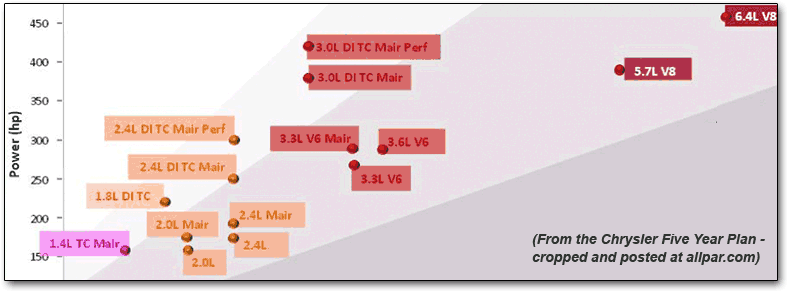
The economy 3.3 has been dropped, but the 3.2 uses lower-friction pistons, narrower sleeves, and smaller journals and main bearings, and different rods, for much less rolling resistance and higher gas mileage. The heads are different, the blocks are the same.
Despite the four variants of the 3.6 already being sold — rear drive (290 hp), AWD (292 hp), FWD (283 hp), and Challenger (305 hp), there are just two head designs, two intake manifolds, and one set of internal components, including cam and pistons (this probably changed when they added the Ram setup, 305 hp, though the rep said the main advantage in the Ram was the space available for the exhaust), according to an SAE article by Paul Weissler. The Challenger's 13 horsepower increase is due to "a more aggressively designed intake air system" which increased airflow from 214 to 220 g/s.
The engine can run on either regular gasoline or E85 fuel without degradation of performance or emissions.
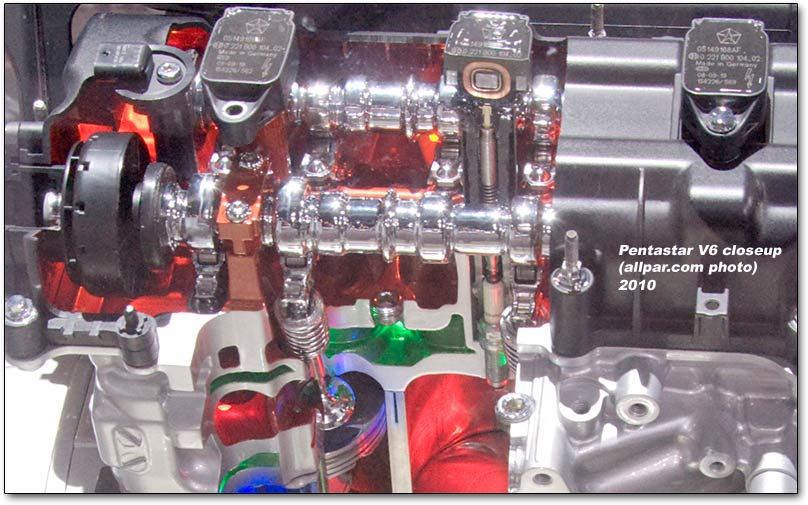
Here are some of the major innovations:
- Variable cam timing with dual independent cam phasing that helps to flatten the power output and dramatically improve idle quality. The system uses separate cam phasers on each cam, achieving better results than the dual variable valve timing system on the World Engine, but with a simpler, more durable design.
- Exhaust manifold integrated into the head itself, cutting parts count
- A chain drive replaces the usual timing belt, for greater longevity and accuracy
- Canister-free oil filter element — prevents landfill, allows incineration; also eases DIY oil changes and prevents ham-fisted oil change places from "holing" or over-tightening the filter
- Oil to antifreeze oil cooler in the "V"
- Regular octane (87) gasoline is used even with the 305 horsepower version on Challenger
- Reinforced nylon cam covers and intake module to save weight and reduce airflow restrictions
- All accessories bolted directly onto the block to avoid vibration and noise
- Lightweight block — saves on aluminum and reduces overall vehicle weight (improving balance, too)
- High-pressure die-cast blocks save on labor, have thinner walls, and are 20 pounds lighter than GM’s V6 blocks, saving around $40 per engine on aluminum and contributing to much lower build costs than GM’s engines.

Ports and manifolds
The engine features high-flow intake and exhaust ports, which in combination with dual independent cam phasing, allows optimum volumetric and combustion efficiency over the full speed and load range. This results in an exceptional, flat torque curve along with high specific power.
The intake valve is a single-piece design, made of forged heat resistant (martensitic) steel; exhaust valves are two-piece designs, with a forged austenitic head welded to a martensitic stem, and both have a nitrided surface treatment to prevent scuffing (except at the tip and lock grooves). Roller rocker arms, pivoting on stationary lash adjusters, activate the valves, which use three bead lock keepers to help rotation and retain the springs.

Timing
The timing drive uses four chains, each of which is a “silent chain link” design to improve sprocket engagement and cut noise, vibration and harshness (NVH). One chain, with a spring-loaded tensioner, drives the oil pump; three drive the camshafts. Primary and secondary camshaft chains use oil pressure controlled chain tensioners; the left secondary uses a ratchet, the right secondary and primary do not. Chain guides and tensioner arms alike are made of glass-filled nylon, with nylon wear faces.
Pentastar V6 cylinder heads
The cylinder heads are made of aluminum, with unique left and right castings and integrated exhaust manifolds. The valves have pressed-in powdered metal guides, which are not serviceable. The valvetrain uses roller rocker arms with hydraulic lifters. Spark plug tubes are pressed into the heads and sealed in place; the tubes have thin walls, and mechanics were advised to be careful when working with them.
Lightweight block
The cylinder block is a high-pressure die cast aluminum design, with an open deck and cut slots between each cylinder; cast steel cylinder liners increase longevity. Three piston oil cooler jets are mounted to the engine block (each cools two pistons) and attached to the main oil gallery.
Four powdered metal main bearing caps are used; they are cross-bolted, with directional arrows molded in. Two-piece upper half thrust bearings at located at the #2 main bearing; they are installed with the oil groves facing outward. The main bearing caps are a cross-bolted, 6-bolt design. Three oil drain back drillings are on each of the cylinder banks, and two knock sensors are in the block valley.
The engine accessories have no brackets; they are bolted directly to the block, cutting vibration. Since the air conditioner compressor and alternator are both bolted to the block, a tensioner is used with the serpentine belt to maintain appropriate tension. The Phoenix engine was designed to be used in either a North-South and East-West configuration.
Refinement was achieved with the help of advanced computer-aided engineering. Structural, intake, and exhaust areas deliver low levels of noise.
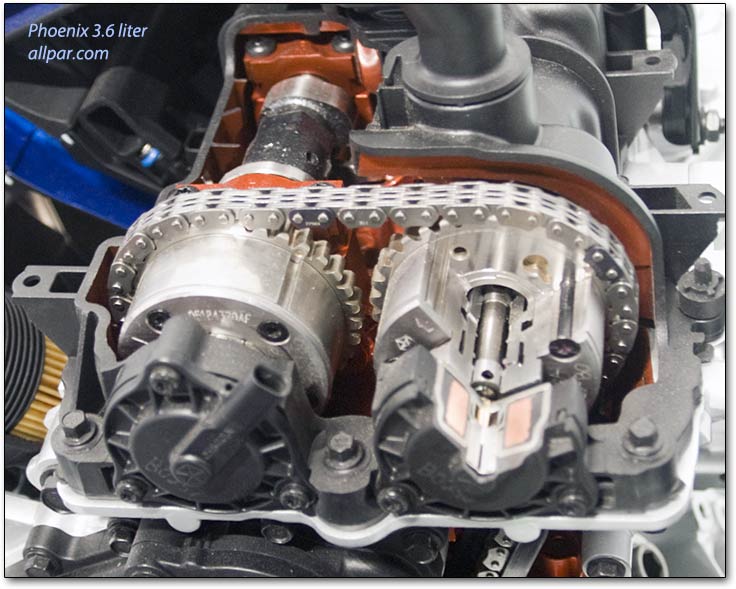
Oil system and engine lubrication
The advanced oil filter system eliminates oil spills, thanks to an incinerable filter element instead of the typical spin-on filters; the filter is conveniently located on top of the engine.
A chain-driven, vane-type variable displacement oil pump adjusts the flow rate and pressure as commanded by the engine management system, which uses a solenoid to drive the pump into low or high pressure mode. For example, below 3,500 rpm, the pump conserves energy by using low pressure; at speeds over 3,500 rpm, the pump switches to high pressure.
A force balance mechanism inside the oil pump adjusts the size of the pumping chambers to alter oil flow. If the oil is cold, the pump reduces the size of the internal chambers. When the oil is hot and thinner, more oil is needed, and a spring increases the size of the pump chambers. This also saves energy.
The pump is driven at a 1:1 drive ratio; its location under the block is more efficient than an on-crankshaft location. An internal, mechanical ball-and-spring relief valve dumps oil into the sump when needed, for conditions such as a cold start with high engine speed. Both pump and pressure regulation solenoid are non-serviceable.
The engine takes six quarts of oil with a filter change. Traditional, non-synthetic motor oil with an ILSAC standard of GF5 is recommended. The standard change interval, with this oil, is 8,000 miles under normal driving conditions.
The oil pick-up tube is supported at the windage tray. Three oil gallery plugs are in the engine block; oil pressure an be monitored with a scan tool. Oil pressure and temperature sensors are on the oil filter housing assembly, which is mounted on top, between the heads; the oil cooler (a plate-style coolant to oil heat exchanger) is mounted to the oil filter housing as well. With Wrangler, specific upper and lower oil pan requirements have been engineered into the engine to provide increased grade requirements, keeping the oil within reach of the pump when the vehicle operates at steep angles (Wrangler also has a higher-mounted alternator to allow for water crossing, and a unique intake system with induction handled by a revised throttle body on the left side, where other Pentastars keep the intake on the right).
Compact V6 engine design
The 60-degree 3.6-liter Pentastar engine is compact and lightweight, with a total length of 503 mm (94mm shorter than the 3.7 and 34 mm shorter than the 3.5). This relieves packaging constraints, allowing more power or smaller engine bays.
Bore and stroke measure 96mm by 83mm. The block is a high-pressure, die cast aluminum unit with cast iron bore liners and aluminum cylinder heads; cast aluminum pistons with low friction rings are fitted to forged steel connecting rods. Pistons have a reduced skirt area to cut weight and friction. Compression ratio for the engine is 10.2:1 for all applications (as of October 2010). Piston cooling jets are fitted to each cylinder, spraying oil onto the piston to prevent detonation, control heat, and allow MDS in the future.

The nodular iron crankshaft is common to all Pentastar engines (as of 2010); it has an 83% increase in fatigue strength due to the rolled fillet process. The crankshaft has four bolts on the main bearing supports; two more are cross-fitted in the main bearing caps providing an extremely rigid bottom end. A structural windage tray reduces oil splash on the crankshaft and cuts power losses from the reciprocating assembly, while increasing structural stiffness and lowering engine noise.
V6 engine intake and exhaust
Cylinder heads are constructed of T7 heat treated aluminum and feature dual overhead camshafts with roller finger followers. On the intake side, valve diameters are 39mm with 17 degrees relative to the bore axis. Exhaust valves are 30mm in diameter and canted at 18.8 degrees. Combustion chamber volume is 52.7cc.
Independent cam phasing also is used on all four camshafts. Torque actuated, the phasers use the natural action of the valve springs to pump the phasers into position, lowering the amount of energy required to move the phasers very quickly. The small size of the phasers combines to reduce weight and allows the camshafts to be spaced very closely together for optimum valve angles and combustion chamber geometry.
Induction is handled through a multi-point port fuel injection system and a lightweight composite intake manifold. Throttle bore diameter is 74mm. Both the intake and exhaust systems have been designed to provide efficient flow characteristics with a minimum amount of restriction in the passages. On the exhaust side, spent gases exit through an integral exhaust manifold that is cast into the cylinder head – unique in the Chrysler engine line-up.
The integral exhaust manifold eliminates the need for separate cast iron or steel exhaust manifolds and contributes to improvements in engine refinement and weight. The integral manifold also results in a broader range of stoichiometric operation reducing fuel consumption during mountain grade and trailer tow driving.
Extremely efficient with advanced emission technology, the new 3.6-liter Pentastar is designed for all future emission standards. This requires no Exhaust Gas Recirculation (EGR) and helps reduce the mass of the engine. The 3.6-liter V-6 will be introduced to meet Federal Tier 2 BIN 5 emission requirements and Ultra-low Emissions Vehicle II standards. The engine also has been designed to meet all known future worldwide emission standards including LEV III and PZEV California standards. For export applications, the Pentastar V-6 is capable of meeting Euro6 standards.
Despite the impressive gains in power, the engine is designed to run on regular unleaded fuel with an octane rating of 87. The engine also can run on E85 blended gasoline.
Other Pentastar V6 engine notes
The long-life spark plugs are installed at the end of a length tube. There is a spring running through the length of the tube, from the conventional-looking plugs up to the coils; the plug appears to be removed via the spring, which is attached to the contact. The tubes are pressed into place and cannot be removed.
Cylinders are numbered front to rear; the right bank has pistons 1, 3, and 5, the left 2, 4, and 6, with a 1-2-3-4-5-6 firing order. The serial number is on the left side of the block, at the transmission flange.
The Pentastar V6 is an interference design; it has valve reliefs but only for clearance under normal conditions. It does have a timing chain, reducing the possibility of heavy damage from a snapped belt. (Thanks, Keith.)
Despite the tremendous potential of the Pentastar V6, it was endangered not by Daimler, which will use it in Mercedes cars, but by Cerberus, which stopped its development while it tried to buy Nissan engines. The Pentastar reportedly did 7% better in fuel economy than the Nissan engine, for the same power output.
Chrysler wrote that: “The new Phoenix of V-6 engines will feature cylinder deactivation (MDS)...the engine will operate efficiently on three cylinders when less power is needed, and in V-6 mode when more power is needed. This optimizes fuel economy when V-6 power is not required – without sacrificing vehicle performance or capability.

“The new family of V-6 engines will feature an aluminum die cast block, dual variable valve timing (VVT) and a two-stage oil pump, among other technologies. The end result is an expected across-the-board V-6 fuel efficiency improvement of six to eight percent – in addition to new levels of V-6 power, performance and refinement.” Allpar note: the key words here are both performance and refinement!
As far as we know, the smaller 3.2 liter displacement will be achieved using thicker cylinder liners, rather than by having smaller block bores or strokes.
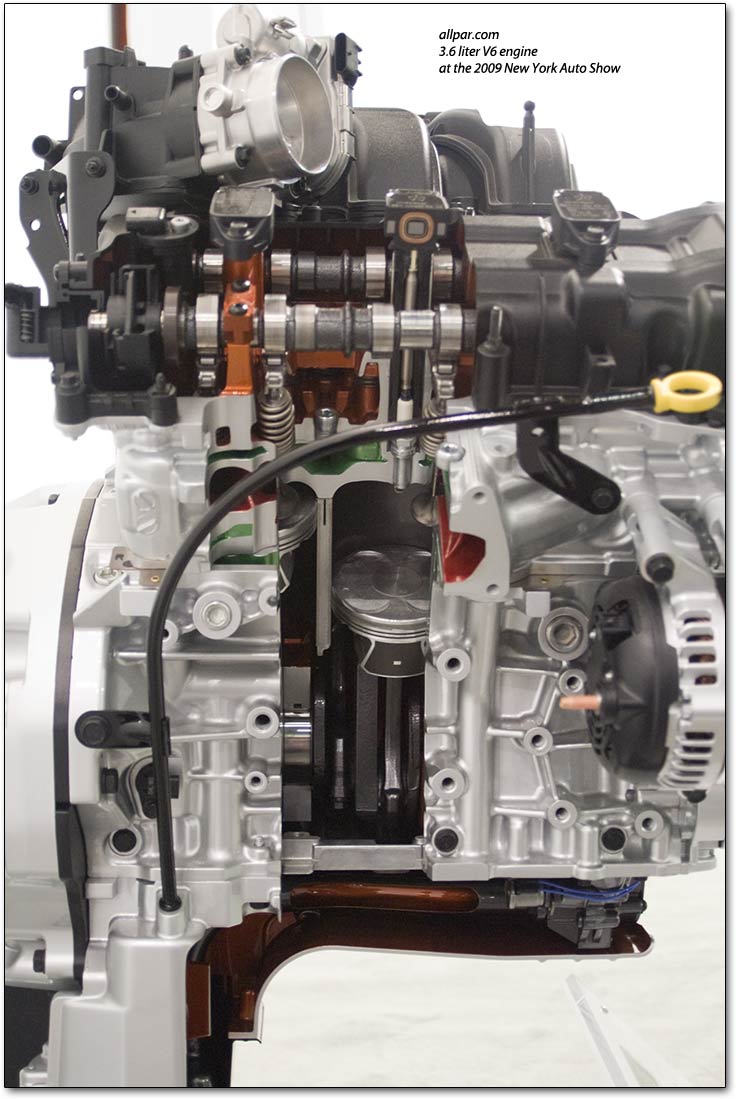
Horsepower and torque improvements
Fully dressed, the new Pentastar V-6 is 94 pounds lighter than the 3.7-liter engine and 42 pounds less than the 3.5-liter.
Horsepower gains have been significant across all models. On the new Jeep Grand Cherokee, horsepower has increased dramatically from 210 horsepower to 290 horsepower (38%). On the Avenger/200, horsepower increased to 283 horsepower from 250.
The 2011 Dodge Charger and Chrysler 300C gained 42 hp, rising to 292 horsepower.
The Pentastar V-6 engine has more torque than any 2010 Chrysler V6, and has a broad, flat torque curve with 90% of peak torque available between 1800 and 6350 rpm.
The engine was originally rated at just 280 horsepower; engineer Phil Jansen wrote, “The engine team did a fabulous job of increasing horsepower and delivering added fuel effciency in the final phase of development.”
Quality and reliability
Quality has been an overriding concern in the assembly plants.
The block is a die-casting; the heads are sand-cast, and undergo serious inspections for cleanliness before reaching assembly plants. The machining department has two parts-washing operations for the heads; one plant worker wrote, “They use an 80 horsepower motor with a 2,500 psi pump about the size of a small diesel motor. To say they come out clean is a gross understatement. The only ‘dirt’ problems I can remember was, a couple of times, having oil pump relief valves sticking with aluminum chips from the vendor — who had all Hell to pay because of it.”
Before the first aluminum block was cast, the new Pentastar V-6 benefitted from more than 45,000 hours of computer analysis to optimize the design of the engine. Once assembled, the engines were thoroughly tested and evaluated on dynamometers and in vehicles. More than 12 million customer equivalent miles were logged on the dynos followed by vehicle testing of nearly 4 million customer equivalent miles.
A test batch of engines were made in February 2009, and sent to Roush Industries (which preps the Challenger drag cars) for extensive hot testing, to find any problems before customers.
